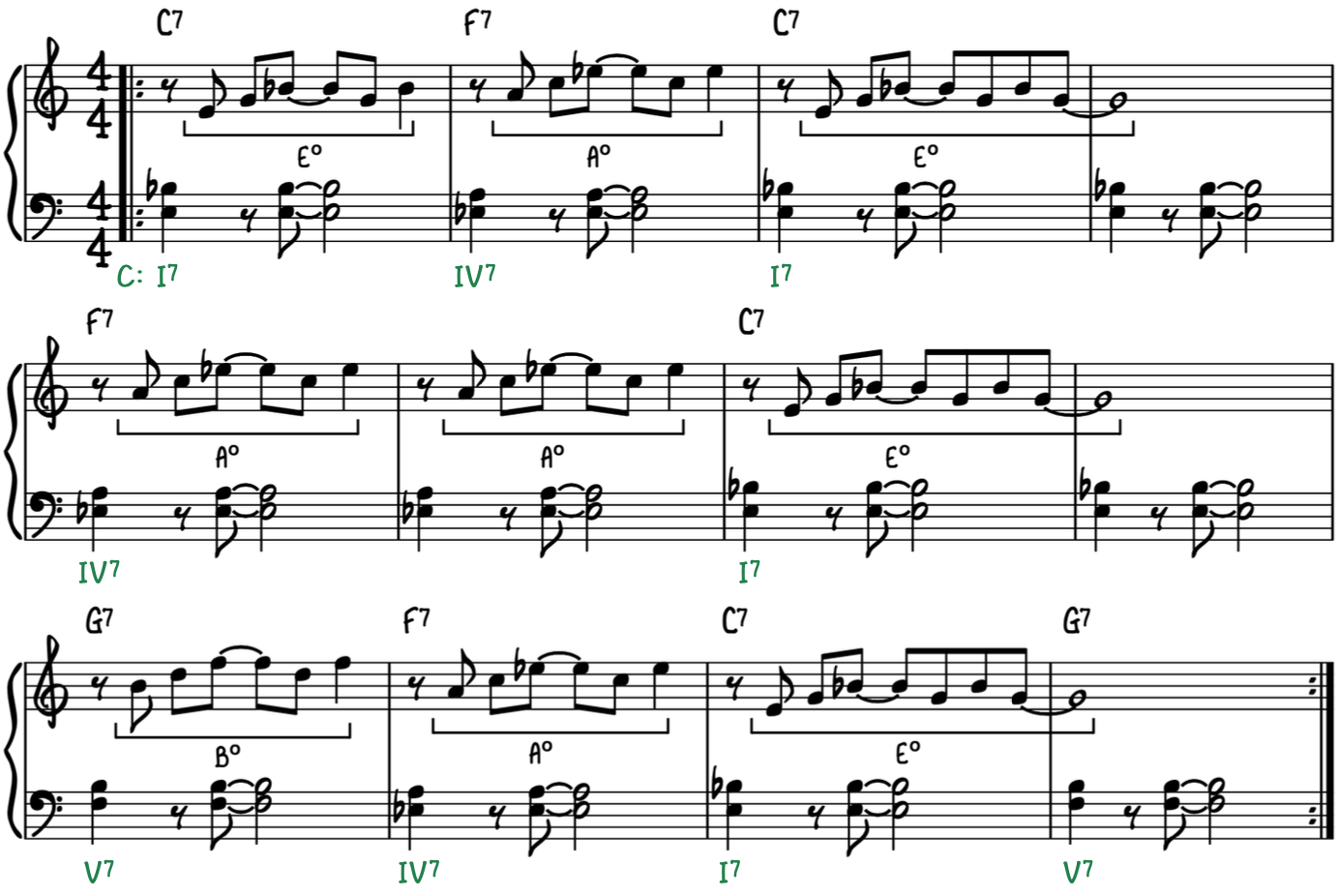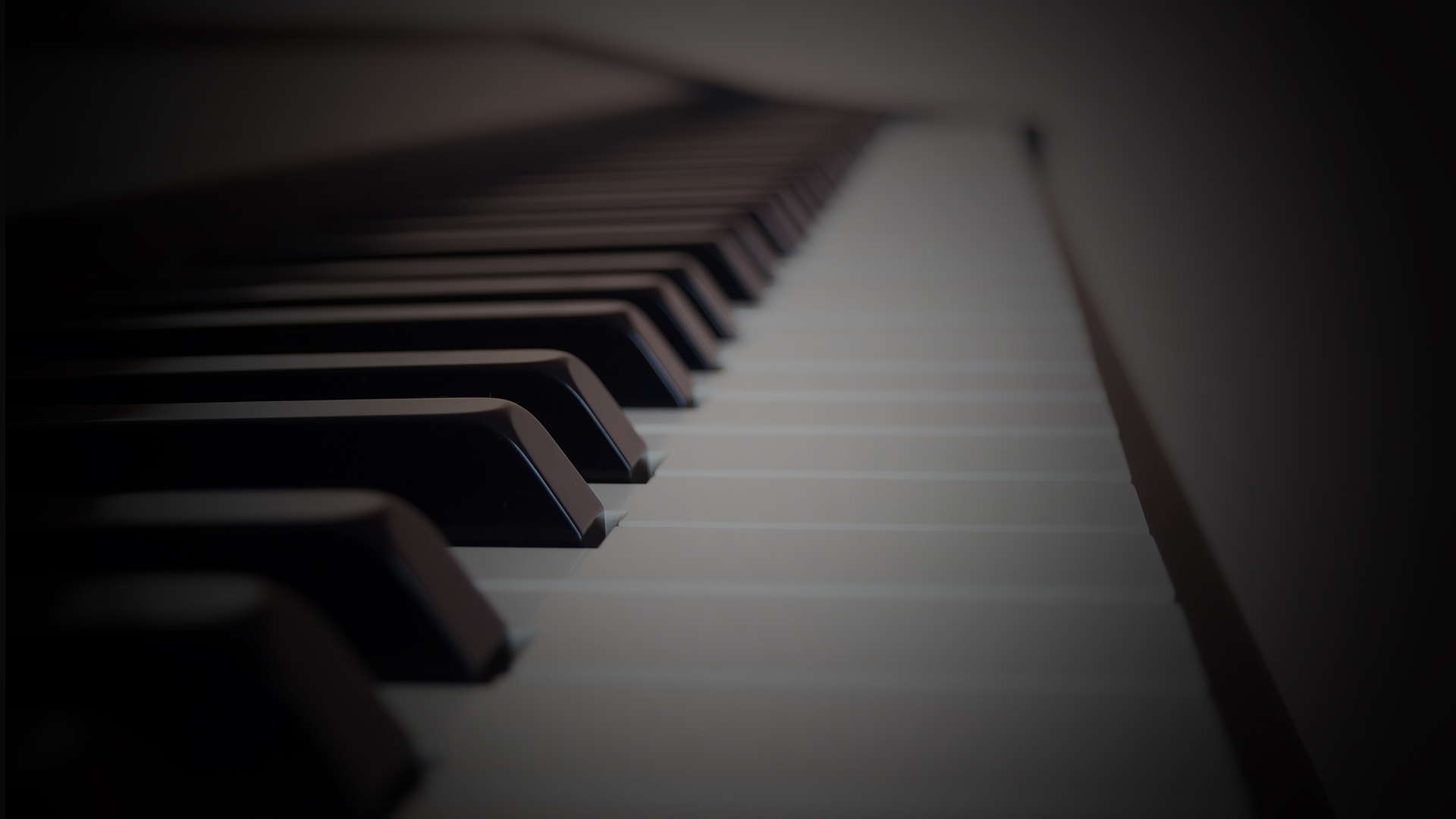Dominant 7th Chords for Piano – Ultimate Guide
Learning Focus
Music Style
Free Lessons
Get free weekly lessons, practice tips, and downloadable resources to your inbox!
Sometimes piano students get intimidated or stumped by certain chord symbols. But if there’s one 4-note chord quality that you must know on piano, it’s dominant 7th chords. In fact, it’s hard to identify a musical genre that doesn’t use dominant 7th chords. These 4-note chords are found in classical, blues, jazz, Latin, R&B, gospel, soul and other contemporary keyboard styles. In today’s Quick Tip, Dominant 7th Chords for Piano – Ultimate Guide, John Proulx shares how to construct, apply and improvise with dominant 7th chords on piano. You’ll learn:
- Intro to Dominant 7th Chords
- Piano Chord Chart of All Dominant 7th Chords
- Beyond the Basics with Dominant 7th Chords
- 3 Improv Techniques for Dominant 7th Chords
This lesson is perfect for early piano students who can already comfortably play triads and want to explore the sound of dominant 7th chords.
Intro to Dominant 7th Chords
What do we mean when we use the word dominant in a conversation about music? In music theory, the term dominant is the proper name given to the 5th scale degree of a major or minor scale—just like we use tonic to describe the 1st scale degree. Unless you have perfect pitch, you typically won’t be able to recognize specific pitches by ear. Therefore, terms like “tonic” and “dominant” allow us to speak of the 1st and 5th scale degrees when we hear them, even before we’ve identified the particular key. Most students can learn to hear a major scale and subsequently identify the tonic and dominant notes, which are commonly called do and sol in the solfège ear training system. Tonic and dominant, or do and sol, or “one” and “five” have a special, foundational relationship in tonal music.
One of the reasons tonic and dominant are so foundational to tonal music is because the movement from the 5-chord to the 1-chord establishes a key center. When we build a triad on the 5th scale degree, it’s known as a dominant triad. Similarly, when we construct a seventh chord on the 5th scale degree, we call it a dominant 7th chord. Thus, a dominant 7th chords is a “five” chord and is frequently denoted with the Roman numeral Ⅴ in the manner Ⅴ⁷.
“That the interval of the 5th dominants harmonic progression is reflected in the use of the term dominant to denote the scale degree a 5th above the tonic and the chords built on that degree.” ¹
—Harmony and Voice Leading, Edward Aldwell & Carl Schachter
So far, we’ve explained that a dominant 7th chord is the Ⅴ⁷ chord that comes from the major scale (and also the harmonic minor scale). In addition, the term dominant seventh chord also refers to the specific chord quality of the Ⅴ⁷ chord. In other words, the label dominant 7th is used to classify a chord sound with a specific construction.
What are dominant 7th chords?
A dominant 7th chord (also dominant seventh chord) is a 4-note chord that has a bluesy or earthy sound. Dominant 7th chords are constructed from the 1st, 3rd, 5th and 7th tones of a Mixolydian scale. An easy way to build a dominant 7th chord is to start with a major triad and add a minor 7th interval above the root. (Think: 1–3–5–♭7). For example, C dominant 7 contains the notes C–E–G–B♭. However, the 5th is often omitted from a dominant 7th chord voicing. In a major key, a dominant 7th chord naturally occurs for the Ⅴ chord. An example of a chord symbol for a dominant 7th chord is C7.
Hint: If you’re not sure how to quickly find the minor 7th interval needed for a dominant 7th chord, here is a quick shortcut. Simply play the root of the chord up an octave and then go down a whole step. For example, since the root of C7 is the note C, play the C an octave higher and then walk down a whole step to B♭.
Piano Chord Chart: All Dominant 7th Chords
For your reference, here is a complete Piano Chord Chart of All Dominant 7th Chords in every key. You’ll see the chord symbol followed by the specific notes on the piano within each dominant 7th chord. Keep in mind, seventh chords should be spelled using every other letter of the musical alphabet. Therefore, D♭7 is spelled D♭–F–A♭–C♭, not D♭–F–A♭–B.
In the next section, you’ll discover various ways to play dominant 7th chords on piano, including chords inversions and other applications.
Beyond the Basics with Dominant 7th Chords
Now that you’ve learned how to build dominant 7th chords, let’s explore some ways in which pianists use these chords. Keep in mind, pianists can play dominant 7th chords entirely with one hand or they can distribute the notes across two hands. Moreover, they can rearrange the order of the notes, which we call inversions.
By the way, all of the examples you see here are excerpted from the downloadable lesson sheet PDF for this Quick Tip, which is included with a PWJ membership. The lesson sheet and backing track appear at the bottom of this page after logging in with your membership. In addition, members can also easily transpose this lesson to any key using our Smart Sheet Music.
Dominant 7th Inversions
All of the examples of dominant 7th chords that we’ve examined so far have been in root position. This means that the root of the chord has been on the bottom with the 3rd, 5th and 7th stacked above it in thirds. However, 7th chords can also be played in three different inversions. For example, if you move the note C to the top of a C7 chord, then the note E is left on bottom…we call this 1st inversion. Next, if you move the E to the top of the chord, then the note G is left on bottom, which we call 2nd inversion. Finally, if we move the G to the top the chord, then the note B♭ is left on bottom, which we call 3rd inversion. The following example demonstrates each of these possibilities played in the right hand.
Blocked Dominant 7th Inversions
If you’re currently seated near a piano, try playing C7 in root position and each inversion as shown in the example above. Afterward, try replicating this example with your left hand also.
Next, let’s play C7 and its three inversions as arpeggios, or broken chords. This simply means that we’ll play the notes one-at-a-time rather than simultaneously. Another way to describe this approach is to say that we’re playing the chord “melodically.” Being able to play dominant 7th chords melodically in each inversion is an important skill for improvising over dominant 7th chords.
Broken Dominant 7th Inversions
The example above represents an ascending broken chord pattern. Next, try playing these broken chords in a descending pattern.
A Closer Look at Dominant 7th Shapes for Piano
In this section, we want to give some consideration to how pianists commonly play dominant 7th chords with two hands. That’s because pianists don’t always play all four notes in the same hand. Instead, it’s fairly common to distribute the four chord tones across both hands. In particular, we’ll examine an technique called triad over root in which the left hand plays the root while the right hand plays the remaining chord tones—the 3rd, 5th and 7th.
Triad Over Root Keyboard Arranging Style
When a pianist uses the triad over root arranging technique, he or she plays only the 3rd, 5th and 7th in the right hand. Since the left hand is playing the root, it isn’t necessary to double the root in the right hand.
An interesting fact about the triad over root technique for dominant 7th chords is that the right hand appears to be playing a different chord. For example, for the chord C7 (C–E–G–B♭), the left hand plays the note C while the right hand plays the notes E–G–B♭. Do you know these right-hand notes by another name? If you said Eº (an E diminished triad), you’re correct! Therefore, C7 is equivalent to the slash chord Eº/C.
Just to be clear, the chord symbol Eº/C is not likely to appear in any sheet music. That’s because music publishers work hard to keep chord symbols as concise as possible in order to enable efficient sight reading. As such, the chord symbol C7 is what you’ll find in print. However, since pianists often play this chord with two hands, they frequently think of C7 as Eº/C.
In summary, the trick to the triad over root technique for dominant 7th chords is to play a diminished triad in the right hand built on the 3rd of the chord. The diagram and example below demonstrates how to practice dominant 7th chords counter-clockwise around the Circle of Fifths while reimagining each dominant 7th chord in the triad over root arranging style.
Dominant 7ths as Diminished Triads Over Root
The triad over root technique is just one way to express basic dominant 7th chords on piano. Professional blues and jazz pianists often include extra notes in their dominant voicings to create a more stylized dominant chord sound for those particular genres. To explore pro-level dominant chord voicings, check out the following courses:
🔎 Piano Chord Extensions (Int)
🔎 Piano Chord Alterations (Int)
3 Improv Techniques for Dominant 7th Chords
Alright, now we’ve come to the application part of today’s lesson where you’ll learn 3 techniques that you can use to improvise over dominant 7th chords on piano. All of the examples will be played over a 12-bar blues progression in C, which uses just three chords: C7 (Ⅰ⁷), F7 (Ⅳ⁷) and G7 (Ⅴ⁷). Let’s take a listen to the basic structure and form.
Blues Chord Progression
Technique #1: Arpeggios
Perhaps the simplest and most straightforward approach for improvising over dominant 7th chords is to use arpeggios (aka: broken chords). This technique is especially useful for students with less improvisation experience.
The following example illustrates how to play an improv line that makes exclusive use of ascending dominant 7th arpeggios in the right hand. Notice that the left hand here uses 2-note voicings containing the 3rd and 7th only, which we call the guide tones.
Technique #2: The Minor Blues Scale
Another effective technique for soloing over dominant 7th chords on a blues is to use the minor blues scale of the parent key. In order to construct a minor blues scale, we use the scale formula 1–♭3–4–♯4–5–♭7. Since we’re playing a blues in C, we’ll use the C minor blues scale over the entire 12-bar form.
C Minor Blues Scale
Let’s listen to an example of a blues piano solo that draws on the sound of the minor blues scale.
Technique #3: Upper Structures
A third technique for improvising over dominant 7th chords involves using upper structure triads. Earlier in this lesson, we discussed the triad over root arranging technique. Well, we can apply the same concept melodically when soloing. To do so, we simply improvise over each dominant 7th chord using a diminished triad built on the 3rd of the chord. For example, we can use an Eº triad over C7, an Aº triad over F7 and a Bº triad over G7. The following example demonstrates this approach.
Conclusion
Congratulations, you’ve completed today’s lesson on Dominant 7th Chords for Piano – Ultimate Guide. Now you have a foundational understanding for how to approach dominant 7th chords on piano whenever and wherever they appear.
If you enjoyed today’s lesson and want to learn more, then be sure to check out the following PWJ resources:
Courses
- Dominant 7th Chord Theory and Application (Int)
- Diatonic 7th Chords Exercises (Int)
- Major Turnaround Exercises with 7th Chords (Int)
- 2-5-1 7th Chord Exercises (Int)
- Play Piano Lead Sheets with 7th Chords (Int)
- Play Piano Lead Sheets with Shells & Guide Tones (Int)
- Chord Shell & Guide Tone Exercises (Int)
- Coloring Dominant Chords with Upper Structures (Adv)
Quick Tips
- 7th Chords for Piano—The Complete Guide (Beg/Int)
- Blues Chords for Piano: The Complete Guide (Beg/Int)
- Jazz Piano Chord Voicings–The Complete Guide (Int)
- The Beginner Jazz Piano Practice Guide (Beg/Int)
- Jazz Piano 10 Steps from Beginner to Pro
- Improvise Diatonic 7th Chords on Piano (Int)
- The Ultimate Beginner Jazz Chord Exercise (Beg/Int)
- 2-5-1 Chord Progression – 5 Levels from Beginner to Pro
Jazz Swing Learning Tracks
Jazz Ballad Learning Tracks
Thanks for learning with us today! We’ll see you next time.
Would you like to comment on this lesson?
Visit this Quick Tip on YouTube
¹ Aldwell Edward and Carl Schachter. Harmony and Voice Leading. 2nd ed. Harcourt Brace Jovanovich 1989, p 60.
 Writer
Writer
Michael LaDisa
Michael LaDisa graduated from the University of North Texas with a major in Music Theory & Composition. He lives in Chicago where he operates a private teaching studio and performs regularly as a solo pianist. His educational work with students has been featured on WGN-TV Evening News, Fox 32 Good Day,...
More Free Lessons
Some jazz standards like “On Green Dolphin Street” mix Latin and swing within the same song…Learn how to master these “transition tunes.”
Learn to play in the exhilarating rock and roll piano style of Little Richard and Jerry Lee Lewis—including grooves, chords, licks and riffs.
Explore the methods and mindset needed to comp on piano in the swing style with this complete guide to jazz piano comping for all levels.
Looking for downloads?
Subscribe to a membership plan for full access to this Quick Tip's sheet music and backing tracks!
Join Us
Get instant access to this Quick Tip and other member features with a PWJ membership!
Guided Learning Tracks
View guided learning tracks for all music styles and skill levels
Progress Tracking
Complete lessons and courses as you track your learning progress
Downloadable Resources
Download Sheet Music and Backing Tracks
Community Forums
Engage with other PWJ members in our member-only community forums
Become a better piano player today. Try us out completely free for 14 days!


























